Discover how to write an RFP that aligns business goals with the right development partner, supported by ready-to-use samples.
As we all know, it usually starts with a simple idea. Your team may have been discussing a new software application RFP, or your current system is just not working in your favour. This is when you realize, it’s time for an upgrade. Whether you are a founder with big aspirations or an engineer at an organization looking for the right technology partner, building a request for proposal for software is a smart strategy to stay organized, focused on the goal ahead of you, and assemble the right team to build your application.
Let’s Take the Stress Out of Starting Your RFP
Documents like RFPs for IT services or application development are very detailed, which can be overwhelming. Various questions pop up in your head. Like, what should you include? Will vendors be able to relate to it? How much detail is too much? Will they even read the whole thing? And what are the chances of attracting the right partners who truly understand your vision?
Our guide provides precise answers to these and more. We will proceed by taking one step at a time and understanding its importance. This will help your message become clearer to the vendors. Once finished, you will have a checklist to draft a comprehensive RFP software development document, be it for a new application or upgrading an existing one.
If you’re planning a detailed proposal, explore our custom software development services for tailored support.
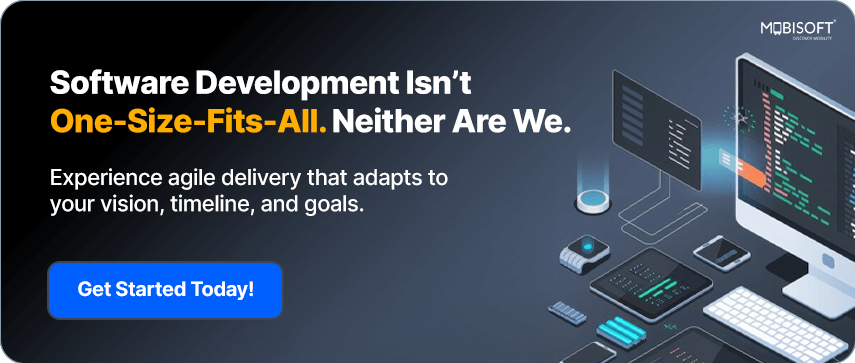
Let’s Start with the Basics
An RFP (Request for Proposal) is one of the easiest and most effective ways to invite experienced and dedicated vendors to share proposals for your mobile app or enterprise software project. You can consider it as a blueprint, a part conversation starter. For example, let's think about a dating profile for your project. It should be honest, clear, and show what you’re really looking for. It also gives potential partners a sense of what works well while being and growing together.
Before moving ahead, here are a few terms that might sound the same, but convey entirely different meanings:
- RFI (Request for Information): Use an RFI when you merely want information, not the service. This is the first document sent for requesting services offered by the vendors. You may send it to multiple vendors at a time to explore the market.
- RFQ (Request for Quotation): After you have gathered the information, you can decide on the one you want to go with and send an RFQ. This asks the vendor to provide the complete breakdown of charges.
- RFP (Request for Proposal): This is the final call. You draft an RFP when you have decided to have a full-time technology partner. This means their assistance and contribution throughout the process, including strategy, planning, design, development, and future maintenance. So you must understand their services, approach, working, and pricing thoroughly.
Understanding RFP, RFI, and RFQ
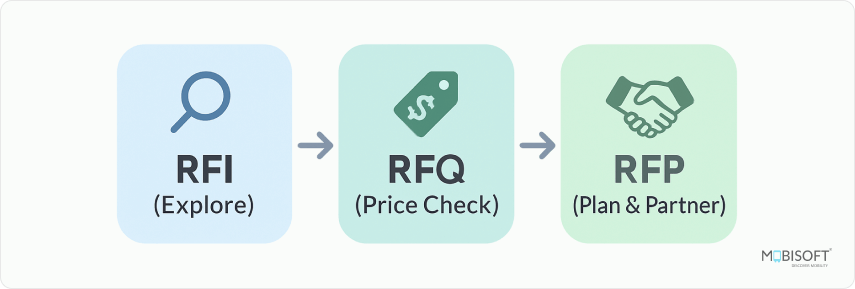
1. RFI – Request for Information
What it is:
It’s like a company saying, 'We’re open to possibilities, show us what you offer and how you can support us.' It’s an informal way to collect ideas and explore what the market has to offer.
Example:
You are a start-up wanting to implement AI in your application. Since you have never done this before, you don’t have a clear idea of the solutions available and how they work. You float an RFI to collect responses from vendors about possibilities, technologies, and approaches.
When to use:
- You are facing issues and also have certain needs, but on the other hand, you don’t know what solutions are available
- You want to understand vendor capabilities before investing time in a full software RFP process
Benefits:
- Helps companies with valuable market insights
- Saves time before drafting a full software application RFP
- Helps identify and shortlist qualified vendors for future detailed proposals.
2. RFQ – Request for Quotation
What it is:
When you already know exactly what you need, and you’re now looking for the cost from vendors. No design suggestion, no strategic input, just the price.
Example:
You’ve already finalized your app design and backend plan. Now you are looking for a development partner to simply execute it, and you’re comparing costs.
When to use:
- You have clear, well-defined specifications (like a shopping list)
- You need pricing information quickly to make a purchase decision
Benefits:
- Enables fast procurement
- Makes it easy to compare vendors based purely on cost
- Suitable for purchasing off-the-shelf products or commodity services
3. RFP – Request for Proposal
What it is:
You’re essentially saying, “Here’s what we want to build, show us your approach, experience, ideas, team, and pricing”. It’s a formal request that merges goals, timelines, budget, and expectations.
Example:
You’re launching a fintech app. You know the features you require, but you are looking for expert input on architecture, security, UI/UX, timeline, etc. So you approach agencies to propose a comprehensive plan.
When to use:
- You have to have strategic input along with execution
- You're evaluating vendors on more than just cost, including expertise, innovation, ideas, and added value.
Benefits:
- Requests vendors to submit well-rounded, in-depth proposals
- Offers visibility into different strategies and technical strengths
- Allows a balanced evaluation of both technical and financial aspects
RFI vs RFQ vs RFP
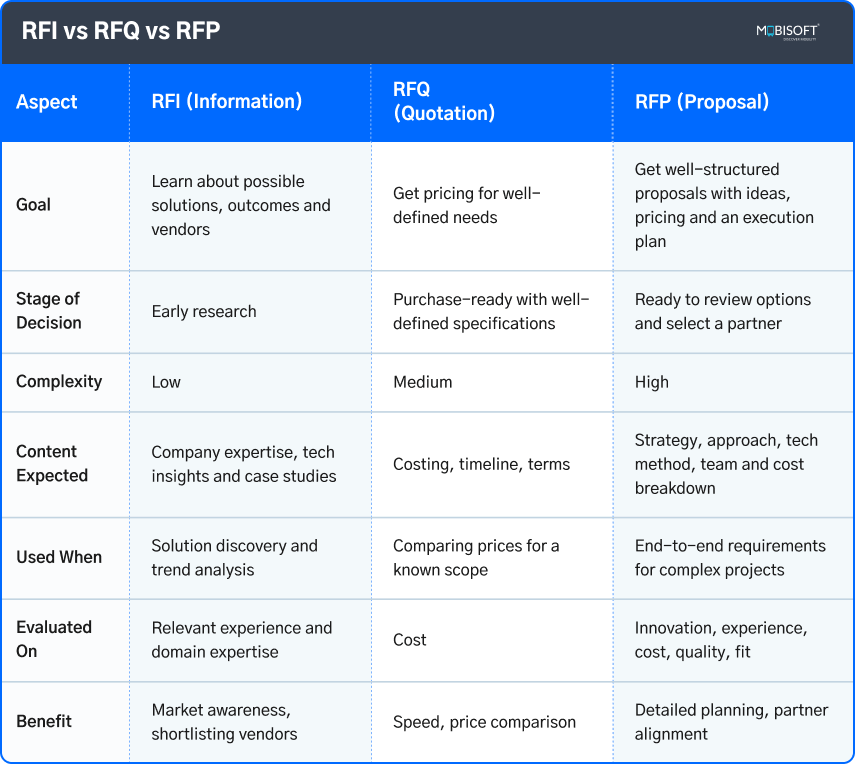
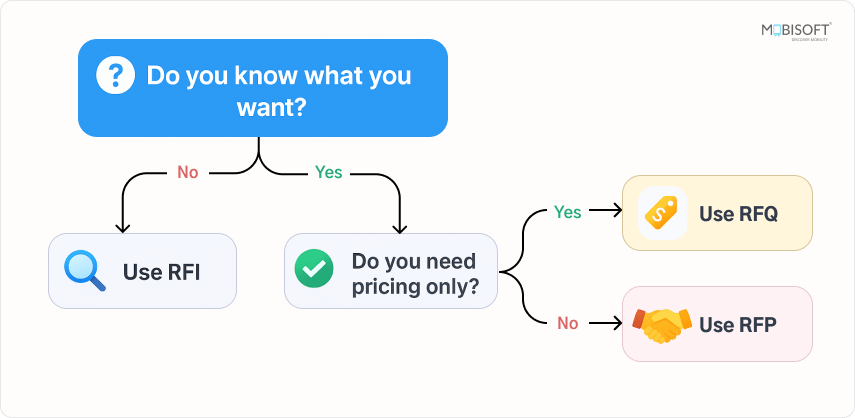
Real-World Startup Scenario
Let’s say a Health tech startup is trying to build a patient booking platform.
- They initiate an RFI to understand HIPAA compliance and telehealth integration options.
- After shortlisting vendors, they issue an RFQ to estimate the cost of integrating a payment gateway.
- Then they launch an RFP for software development to request proposals from vendors who will design, build, test, and support the entire platform.
If you’re a new business, check out our guide on choosing the right mobile app development partner for startups
Starting Your RFP Document
What Should Be on the First Page?
Before diving into the details, let’s begin with the front page of your software application RFP, because first impressions always matter. Here’s what your RFP Title Page should include:
- RFP Title: For example, Request for Proposal (RFP) - Mobile App Development for [Application Name]
- Organization Logo & Name: Add your company’s branding, as it adds legitimacy and identity.
- RFP ID or Solicitation Number (if applicable): Internal tracking number, especially useful for enterprises and government organisations.
- Important Dates Snapshot: Place the following in a neat, easy-to-scan block.
- RFP Issue Date
- Deadline Date for Vendor Questions
- Pre-Proposal Meeting (if applicable)
- Proposal Submission Deadline (PDD)
- Contact Information: List the person or team handling RFP software development queries.
- Name
- Phone (if necessary)
For businesses seeking expert collaboration, partnering with a trusted mobile app development company can streamline the process
Background & Purpose
Create the stage and explain the ‘why’.
Your request for a proposal for software should begin by answering the question: “Why are we doing this?”
This part will help vendors understand what your business exactly is, the issue at hand, and what you aim to achieve.
Include these key elements:
- Company Background: Briefly describe your organisation’s domain, mission, or product. Don’t overdo it; keep it relevant to the project.
- Project Objective: What’s the big-picture goal? Are you launching a new app? Rebuilding an old one? Unifying backend systems? Be clear and specific.
- What’s Expected from the Vendor: Mention the scope broadly: Are you seeking just development, or also UI/UX, QA, post-launch support, or all of the above?
For example:
- [Your Company Name] is a fast-growing healthcare technology company in need of an app to manage all operations. You want the app to be user-friendly for all age groups, especially the elderly. The main feature should be the appointment dashboard and prescription records. It should also have a chat interface to allow patients easy connectivity with healthcare professionals at the time of need.
- We seek submissions from skilled app development companies to create, develop, and sustain this platform, potentially including custom APIs, a centralized admin dashboard for clinics, and connections to current electronic health record (EHR) systems.
- The selected partner will work in close partnership with our medical operations and product teams, with the choice made through a clear and competitive assessment process that follows the software RFP process.
Validity of the Proposal
Lock in terms while you decide
Consider this as pinning down the vendor's commitment. You're requesting they keep their pricing and terms locked in for some window of time so your team can review.
For Example: “The proposal will remain valid for 90 days from the Proposal Due Date (PDD).”
This provides your team time to complete evaluations and get internal approvals without modifying price or scope shifts.
Vendors may request price adjustments due to market conditions and resource changes. A clear validity clause secures both sides during the decision window.
Schedule of the Selection Process
Provide a simple and clear schedule to help vendors plan their timeline and resources effectively. It shows that you are structured, professional, and following the best practices of an RFP template for software vendors.
Sample Schedule Table:
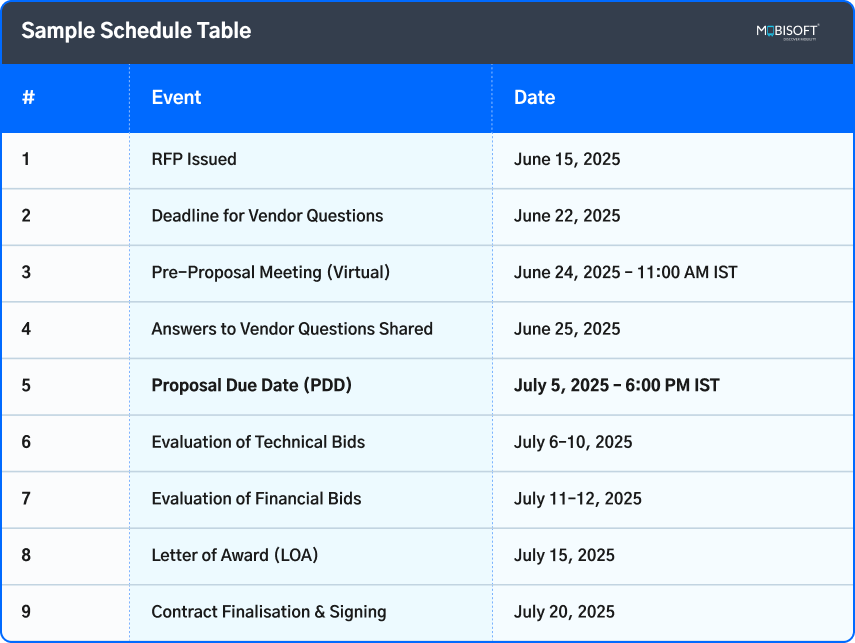
You can highlight important deadlines (like PDD) in bold or colour for better visibility.
Pre-Proposal Queries & Communication Instructions
Ensure clear communication by inviting questions before proposal submission. This helps vendors prepare their best possible response and also keeps the software RFP process transparent.
Include the Following:
- Contact Person’s Name & Role
- Email Address for Inquiries
- Cutoff Date for Submitting Queries
- Pre-Proposal Meeting Details (if applicable)
Example:
All questions related to this RFP must be submitted in writing via email by June 22, 2025, to:
Contact Person: Peter Fox
Designation: Head – Strategic Digital Initiatives
Email: rfp.submission@clientdomain.com
A virtual pre-proposal meeting will be held on June 24, 2025, at 11:00 AM IST via Google Meet. The meeting link will be shared with all registered participants.
Proposal Submission Guidelines
Though this section is very important, it still goes overlooked because vendors need clear and precise instructions on how and where to submit.
You have 3 common methods:
Email Submission
- All proposals should be submitted in PDF format only via email to: rfp.submission@clientdomain.com
- Subject Line Format: RFP Response – [Company Name] – [RFP Name]
- (Additional points to consider) File size should not exceed 20 MB. Large files are to be sent via a secure file transfer utility (e.g., WeTransfer, Google Drive link with permissions defined).
Online Portal Submission
- If you’re using an e-procurement platform, refer to the following example
- Proposals should be submitted online via: https://xyzprocure.com/clientrfp
- Vendors must register using a valid email ID and upload digitally signed documents to submit the response.
[Provide a link to platform instructions or FAQ for first-time users.]
Hard Copy Submission (To save paper you can skip this)
- Submit 2 printed copies of the proposal in a sealed envelope labeled:
- RFP Submission – [Company Name] – [RFP Name]
- Deliver to: [Valid Office Address]
Remark: Proposals must reach the address by July 5, 2025, at 6:00 PM IST.
Optional: Disclaimers (If Applicable)
If you prefer to retain discretion or legal certainty, add a short section:
- [Your Company] reserves the right to accept or decline any or all proposals without providing any reasons.
- Submission of a proposal does not guarantee the project will be awarded.
- Vendors will pay for everything you include in the proposal as they develop the proposal.
Once you properly outline the basic structure of your RFP, the next and probably most important step is to help vendors understand the real scope of what you are asking to be developed. The success of any RFP software development effort depends on how clearly you define expectations in terms of both functional requirements and technical scope.
Now, let’s know the process of defining a complete implementation scope, including what platforms you wish to target, the must-have features, integration requirements, performance standards, and more.
Defining the Implementation Scope & Expectations
This section of your RFP is where you establish the direction for the entire project, helping vendors understand the depth and complexity of your mobile app development requirements. A well-defined scope not only results in better responses but also avoids scope creep and missed expectations post-project award.
If the vendors do not understand what you are trying to build, your RFP process will be full of confusion, delays, and misaligned proposals. Stats show that enterprise-level companies (5,000+ employees) win about 47% of RFPs they participate in, slightly ahead of mid-market companies at ~45% win rate.
This is because they explicitly communicate the purpose of the app, its deployment, and the external integrations used. Companies that follow this structure often achieve the kind of efficiency seen with the best RFP software, ensuring clarity at every step.
Source: 46 RFP Statistics on Win Rates
1. Functional Requirements (What the App Should Do)
Start by listing the key features of your app. This doesn’t require being written in technical language. Just describe what your app users should be able to do.
How to write it:
You can Group features by user type or module, and mark them as:
- Must-Have (for MVP)
- Nice-to-Have (optional)
- Future Consideration (not to be quoted now, but mentioned for roadmap)
Example Format:
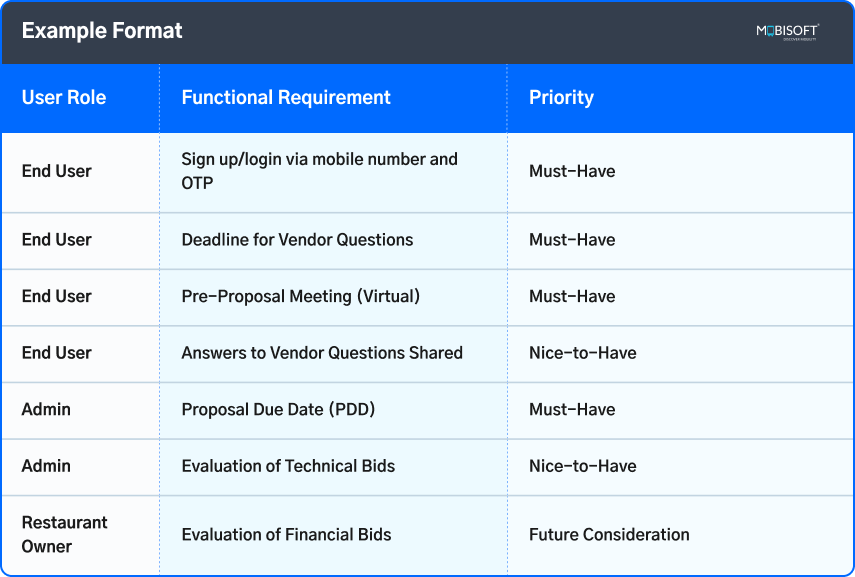
Pro Tip:
The clearer your list is, the easier it is for vendors to scope and estimate timelines accurately. Avoid combining too many features into a single line.
We also provide enterprise app development solutions for businesses aiming at long-term digital growth.
2. Platform & Technology Scope
Let vendors know where the app needs to run and what your preferences are for how it's built.
What to cover:
- Which platforms you are targeting (Android, iOS, Web)
- Whether you prefer native development or a cross-platform approach
- Whether you expect the vendor to handle the backend or integrate with something existing
- Whether an admin panel (for your internal use) is required
Example:
We require an application that can run under iOS and Android operating platforms as well as under a web-based dashboard. In pursuit of offering a single cross-platform solution, examination of React Native is being considered. The web dashboard is fundamental to the tracking of performance, user interaction, and the running of services. The backend solution employs the technology of Python (Django) blended with a PostgreSQL database, to be managed by the development partner. To ensure real-time registration of all interactions with customers, it is important that the system be integrated with the HubSpot CRM that is already in use by us.
Pro Tip:
Even if you're uncertain about technology stack options, it’s beneficial to convey preferences (e.g., maintainability, scalability) or limitations (e.g., CRM integration, current APIs) in the RFP for app development.
Discover more possibilities with our web application development services to build scalable solutions
3. Third-Party Integrations
Call out any tools, services, or APIs that need to be part of the application. Clear integration requirements make your RFP for software development more vendor-friendly.
What to include:
- CRM tools (Salesforce, Zoho)
- Payment gateways (Stripe, Razorpay, PayPal)
- Maps (Google Maps, Mapbox)
- SMS/Email (Twilio, SendGrid)
- Social login (Facebook, Google, Apple)
Example Statement:
- The app should integrate with the following third-party tools:
- Google Maps API for location-based restaurant discovery
- Razorpay for in-app payments (if paid features are enabled in the future)
- Salesforce CRM for syncing user activity logs
- SendGrid for transactional emails (welcome, password reset, etc.)
Pro Tip:
If integration is essential, provide sample workflows or expected data flows. For example: “When a user posts a review, it should be tagged to their Salesforce contact and synchronised within 2 minutes.”
4. UI/UX Design Requirements
You don’t need to include wireframes here, but vendors must know whether:
- You already have design assets or need them to be created
- You expect branding adherence (logo, colours, font)
- You expect usability testing or simply clean visuals
Example Statement:
The contractor will be tasked with developing the entire UI/UX design for mobile and web platforms. We will provide branding elements (logo, brand colors, typography rules). Wireframes and design prototypes need to be evaluated every week. The design must be flexible, easy to use, and customized to meet the guidelines of both iOS and Android (Material/Flat design).
Pro Tip:
Clearly state if you want the app to be accessible for visually impaired users or to comply with WCAG standards as part of your UX design process.
Not sure where to start? Our low-code app development guide offers fast and flexible approaches
5. Testing & Quality Assurance (QA)
Don’t assume that the QA is included in the app development RFP process. Define it explicitly.
What to include:
- Target devices and operating systems
- Testing types: Functional, Regression, Load, Usability
- Tools preferred (if any)
- Bug-fixing and release cycle expectations
Example Statement:
The vendor must conduct end-to-end functional and regression testing on:
- Android (v11 and above)
- iOS (v14 and above)
- Web: Chrome, Safari, Edge (latest versions)
UAT should be conducted with our internal team 2 weeks before going live. All bugs must be fixed within 48 hours of reporting during the UAT phase.
6. Analytics & Admin Reporting
Track what matters, from user activity to admin insights.
Data collection and analysis are important for your mobile app RFP. Define what data you want to track, both for user engagement and admin decision-making.
Example Statement:
The mobile app should integrate with Firebase Analytics to track:
- Daily/Monthly active users
- Feature usage
- User retention and churn rates
The admin panel should provide reports on:
- Most Active Users
- Top-rated or Popular Restaurants
- Most Reported Content
- Average Review Rating Trends
Pro Tip:
Use this section to mention any BI/reporting tools your internal team prefers (e.g., Tableau, Power BI integration).
7. Non-Functional Requirements
Define speed, scale, and stability.
Define speed, scale, and stability in your RFP for app development. It’s all about performance, scalability, and reliability.
Examples:
- App must load within 2 seconds on 4G networks
- Support offline access for cached content
- Handle 100K daily users with real-time updates
- Backend response time < 500ms
Example Statement:
The app should be highly responsive and optimised for low-network usage.
- Page load time should not exceed 2 seconds on 3G/4G networks
- Caching must be implemented for restaurant data
- The backend should scale to support 10,000 concurrent sessions
8. Security & Compliance
Remember - Security isn’t optional
It’s a must-have in any RFP for IT services, especially when handling payments or user-generated data.
Include:
- Secure login (OTP, OAuth)
- Data encryption (at rest and in transit)
- Token-based APIs
- Compliance with local regulations (GDPR, CCPA, PCI-DSS)
Example Statement:
All APIs must be protected with OAuth 2.0. User data must be encrypted in transit using HTTPS/TLS and at rest in the database. The system must be compliant with GDPR and must store data only on India-based servers (if government policy applies).
9. Support & Maintenance
Clarify expectations beyond launch.
Example Statement:
The vendor must provide 3 months of post-launch support, including:
- Monitoring for crashes and bug resolution
- Minor UI/UX fixes
- Monthly app health reports
SLA:
- High priority bugs: Response in 12 hrs, Fix in 48 hrs
- Medium: Response in 24 hrs, Fix in 72 hrs
- Low: Fix in next sprint
10. Timelines & Milestones
Provide a roadmap. Don’t over-engineer it, just define expectations so vendors can align delivery schedules in their proposal response.
11. Budget Range (Optional but Recommended)
Sharing your budget range saves time and prevents unrelated proposals in the mobile app RFP process.
Example statement:
We project a budget between USD 25,000 and 30,000, which includes design, development, backend, admin panel, and initial support
12. Training & Knowledge Transfer Expectations
Great apps need great handovers
Even the best app will face adoption challenges if your internal team isn’t prepared to use it effectively. This section ensures that vendors factor in time and effort to properly hand off the system, tools, and workflows.
What to include:
- Who needs to be trained? (Admins, marketing team, IT team, customer support)
- What format do you prefer? (Live sessions, recorded videos, manuals)
- Do you expect sandbox or training environments?
- Are periodic refresher sessions expected post-launch?
Example Statement:
The vendor must provide a comprehensive training plan for the following groups:
- Admin Users: Training on managing users, content, and the analytics dashboard
- Support Team: Overview of user issue logs and escalation process
- Marketing Team: How to generate and export engagement reports
Training should include:
- 2 live online sessions (90 mins each) with recordings
- Step-by-step user manuals or SOPs (PDF format)
- Q&A follow-up session after 1 week of launch
- The vendor should also provide sandbox/staging access for practice sessions.
Pro Tip:
If your team is non-technical, ask for simplified onboarding documentation with visuals or screenshots. This also helps during team transitions.
Two important tasks are now complete:
- Defining the implementation scope.
- Specifying the design, technical, and overall support expectations.
The vendor now has all the important information to respond, but one.
The vendor’s response might lack clarity, detail, and the depth you expect, because you have still not mentioned those. This can result in misunderstandings and delayed responses.
The next section, therefore, points out the things every service offering business should keep in mind. This small checklist will help with a consistent, well-defined, and extensive proposal.
Below is an example of a well-structured proposal response. Include everything mentioned in the following response to draft a well-defined and comprehensive response.
Learn how our end-to-end product development services simplify delivery from concept to launch.
Crafting a Winning Response: What Vendors Must Include in Their Proposal
Set the structure, and let the best proposal rise.
Explaining what you require in the services is important. But setting an expectation of the correct response in your RFP for software development is essential as well. This helps vendors draft a document that is easy to comprehend and analyse. As a result, you receive a highly relevant response, much easier to compare and decide. Among proposal teams using fully adopted digital tools, 75% always finish their RFP proposals on time, which improves reliability and vendor confidence.
Below is a recommended outline that you can include in your RFP submission format or “Response Structure.” This helps vendors provide clarity and saves everyone time during evaluations.
Source: 11 Interesting RFP stats
Recommended Proposal Structure for Vendors
1. Cover Letter / Executive Summary
What It Should Include:
- A brief, personalised introduction
- A statement of understanding of your project
- Why the vendor is uniquely suited to deliver
- Point of contact information for follow-up
Example Tip for Vendors:
“Keep this section crisp, think of it like a trailer. Highlight your value proposition and past relevant work in 1 page max.”
2. Company Profile & Credentials
What to Ask:
- Company overview (background, vision, office locations)
- Team size and organisational structure
- Relevant experience in the industry
- Key clients and success stories (with links or case studies)
- Awards and partnerships (e.g., Google, AWS, Microsoft)
Example Statement:
“Please provide 2–3 relevant client case studies of software application RFP projects, ideally with metrics like user engagement, retention, or scale.”
3. Understanding of the Project
Why It’s Critical:
You’ll know which vendors actually “get” you. Ask vendors to summarise:
- Their interpretation of your goals
- Key challenges as they see them
- User personas or journeys (if applicable)
- Any risks or assumptions they identify
Tip: “This section often separates the pretenders from the real contenders. Look for thoughtfulness here.”
4. Proposed Technical Solution
What to Include:
- Tech stack (e.g., Flutter, Kotlin, Node.js)
- System architecture overview
- 3rd party tools/plugins proposed
- Hosting/DevOps approach
- Approach to scalability, maintainability
Optional Request:
“If applicable, please describe how your team can integrate with our existing backend or CRM (e.g., Salesforce).”
5. UI/UX Approach
Things to Ask For:
- Their design approach (user research, wireframes, usability testing)
- Sample design sprints or process walkthrough
- Accessibility and responsiveness considerations
- Tools they use (e.g., Figma, Adobe XD)
Optional: “Please share design samples or links to live apps developed by your team.”
6. Project Plan & Timeline
What Vendors Should Provide:
- Phased breakdown (e.g., Discovery → Design → Development → QA → Launch)
- High-level Gantt or milestone chart
- Assumptions regarding client-side availability or inputs
Sample Request: “We prefer agile sprints of 2 weeks. Please indicate how you manage timelines and review cycles.”
7. Team Composition
Details to Include:
- Names and designations of core team members
- Brief bios or CVs (esp. PM, Tech Lead, UX Lead)
- Allocation percentage (Full-time/Part-time)
- On-site vs. remote distribution
Pro Tip: “Ask if any team members are freelancers or subcontractors. Transparency here builds trust.”
8. Quality Assurance & Testing Plan
Expectations:
- Manual vs. automated testing coverage
- Types of testing (functional, regression, device compatibility)
- Bug tracking tools (e.g., Jira, TestRail)
Ask Vendors To Mention: “How many test cycles are included? How do you ensure zero critical bugs at launch?”
9. Training & Handover Plan
As Per the Earlier Section, Request:
- Training formats (recorded/live/manuals)
- Knowledge transfer documentation or materials
- Post-handover support commitments
10. Support & Maintenance Proposal
Ask Vendors to Include:
- Post-launch support duration (e.g., 3 months, 6 months)
- SLA commitments
- Hotfix turnaround time
- Long-term AMC (Annual Maintenance Contract) options
11. Cost & Commercials
Must-Have Breakdown:
- Total project cost
- Phase-wise or milestone-based cost breakdown
- Payment terms (e.g., % on Design Approval, UAT, Go-Live)
- Taxes, currency, and exclusions.
Optional: “You can also request alternate pricing for optional features or long-term engagement models.”
12. Legal & Compliance Info (optional)
Useful Add-ons:
- NDAs, IP ownership clauses
- GDPR/data protection compliance
- Any applicable licenses used in development
13. References & Testimonials (Optional)
You can ask vendors to provide:
- 2–3 client references (with name, designation, contact info)
- Short testimonial quotes (can be anonymised if under NDA)
14. Proposal Checklist (for Vendors)
End this section with a table or list that vendors can use to self-verify before submission.
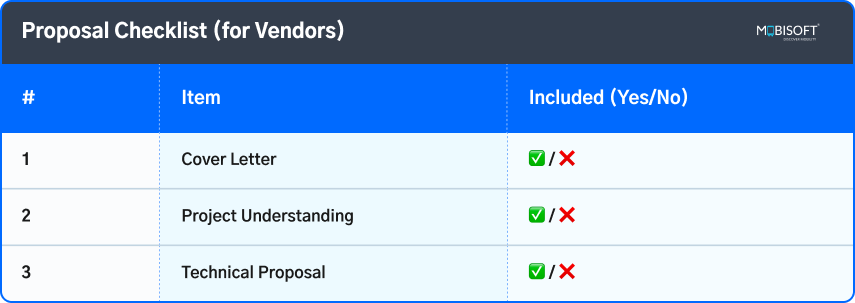
Following this structure and ensuring the above checklist immensely helps the internal team in assessing and deciding.
We are moving into the final stages of drafting the perfect RFP. Having set the expectations for both the service and response, it is also important to let the vendor know on the basis on which their proposal will be evaluated. For a deeper dive, our MVP tech stack guide can help you choose the right technologies
Define Clear Evaluation Criteria in Your RFP: How to Do It Right
This is a crucial part of your RFP because it will allow your potential partners to align their services with your goal. In contexts (like government procurement) where RFPs are vague or lack clarity, vendors report that up to 70% of RFPs they see are not ones they’d plausibly bid on.
Clearly defined evaluation criteria in the UX design process or digital solution procurement:
- Maintains a transparent and objective selection process.
- Helps vendors tailor their proposals more effectively.
- Saves you time when reviewing multiple bids.
- Creates a shared understanding across internal decision-makers.
This way, both the vendor and the client understand each other’s work and requirements, avoiding misunderstandings later on.
Source: Improving RFPs with user research
Where to Place It in the RFP Document
I recommend placing this section under a dedicated header like:
- Evaluation Criteria & Process
- Proposal Review Methodology
- Selection Process
What to Include in the Evaluation Criteria Section of Your RFP
Here’s a way to organize this part in a vendor-friendly and impartial manner:
1. Purpose of the Evaluation Section
Begin with a brief paragraph that establishes the setting. For instance:
Every proposal submitted will be assessed on a mix of technical comprehension, execution plan, team qualifications, and market value. This procedure aims to guarantee a clear and just choice of the most competent vendor.
2. Explain Your Evaluation Process Clearly
Your RFP must showcase the strength of the design process in UX and technology selection, answering the “How, Who, and What”:
- How many assessment phases will there be? (e.g., Technical + Financial)
- Who will assess the proposals? (e.g., Internal Review Committee)
- What are the essential qualification standards? (e.g., Technical score threshold)
Sample format:
The evaluation will be conducted in two stages:
Stage 1: Technical Evaluation
Stage 2: Financial Evaluation (only for technically qualified vendors)
Proposals scoring less than 70 out of 100 in the technical evaluation will not proceed to the financial evaluation stage.
Simple and Recommended Evaluation Criteria (For Most Projects)
Here’s a straightforward and effective evaluation model that works well for most digital platform RFPs.Especially if you’re building a user experience design project like a mobile app, website, or admin panel.
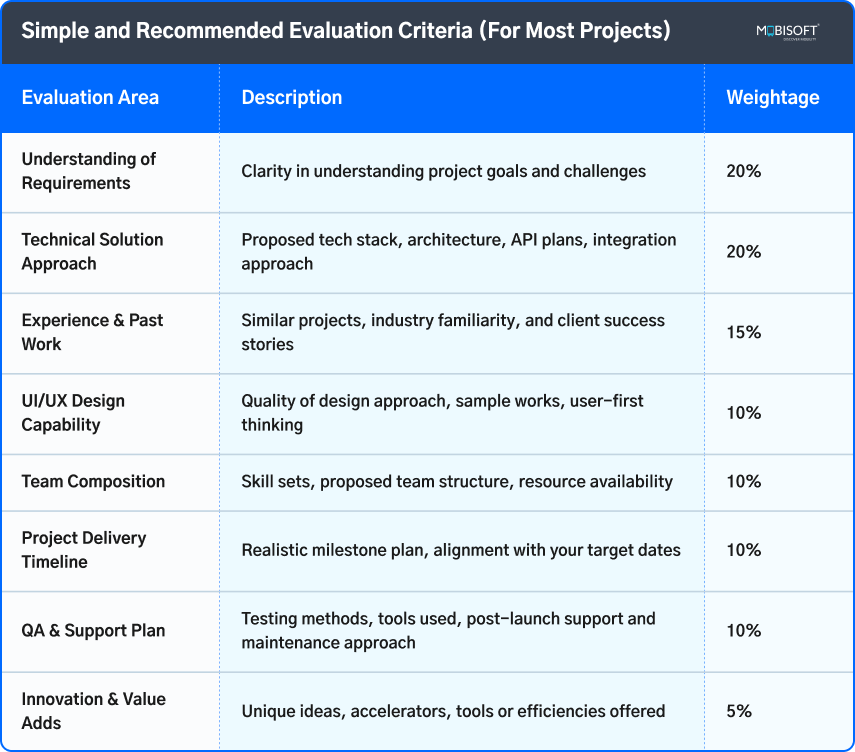
Total: 100%
Tip: Customize the weightage to reflect your project priorities. For example, increase design weight if UX is crucial.
Alternative Evaluation Models (Choose Based on Your Project)
Scoring models will vary based on the type of projects and what a company needs. Here is a list of a few important assessment formats that you can use:
1. QCBS – Quality and Cost-Based Selection
Use when technical excellence matters more than the lowest bid.
How it works:
Assign 70% weight to the technical evaluation and 30% to the financial evaluation. Normalise scores to a 100-point scale, then apply the formula:
Final Score = (Technical Score × 0.7) + (Financial Score × 0.3)
If you want your product to stay competitive in the long term, this evaluation method is best for you. It is preferred for projects where cost-cutting is not an option.
2. Mandatory Compliance Checklist (Pass/Fail Format)
If you're at an early MVP stage or the project is straightforward, use a simple yes/no compliance list for critical capabilities.
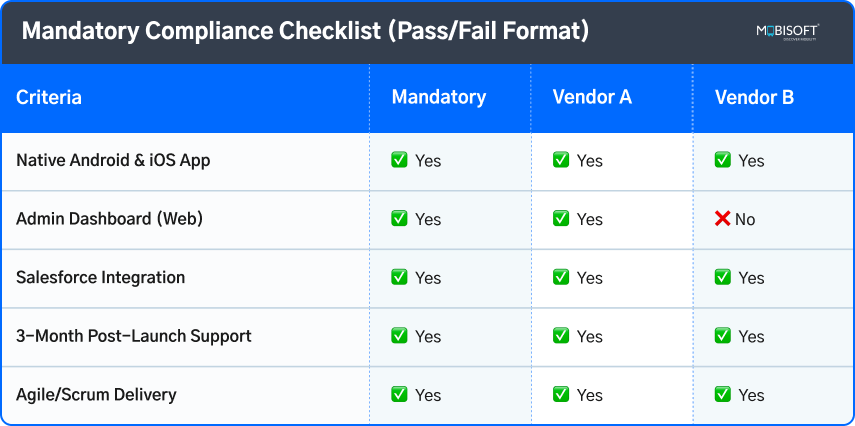
Only vendors meeting all mandatory items qualify for further evaluation.
3. Multi-Stage Evaluation with Vendor Presentation
This model suits more complex digital transformation projects or RFPs where stakeholder buy-in is crucial.
Stage 1: Technical Evaluation (document-based)
Stage 2: Financial Evaluation (top 3–5 vendors only)
Stage 3: Live Presentation / Demo (top 2–3 finalists)
Pro Tip: In your RFP, specify:
An in-person meeting is usually held among the shortlisted vendors. It helps vendors as well as companies to understand each other's proposals and answer domain-specific questions.
Define Your Evaluation Committee (optional)
Because optional advice often carries unexpected value.
You can also guide vendors on who will be evaluating. This helps build trust.
A quick highlight:
An internal committee with members from different teams, such as engineering, management, operations, product, and procurement, is set up. They make the final decision of who to partner with.
Quick Tips for This Section in Your RFP Document
Because they turn confusion into clarity
- Use bullet points or tables for easy-to-read criteria.
- Be clear about scoring thresholds (e.g., minimum technical score of 70)
- Align your criteria with your project’s success drivers (e.g., speed, quality, integrations).
- Avoid vague terms; specificity helps vendors respond accurately.
RFP Document Preparation Checklist for App Development
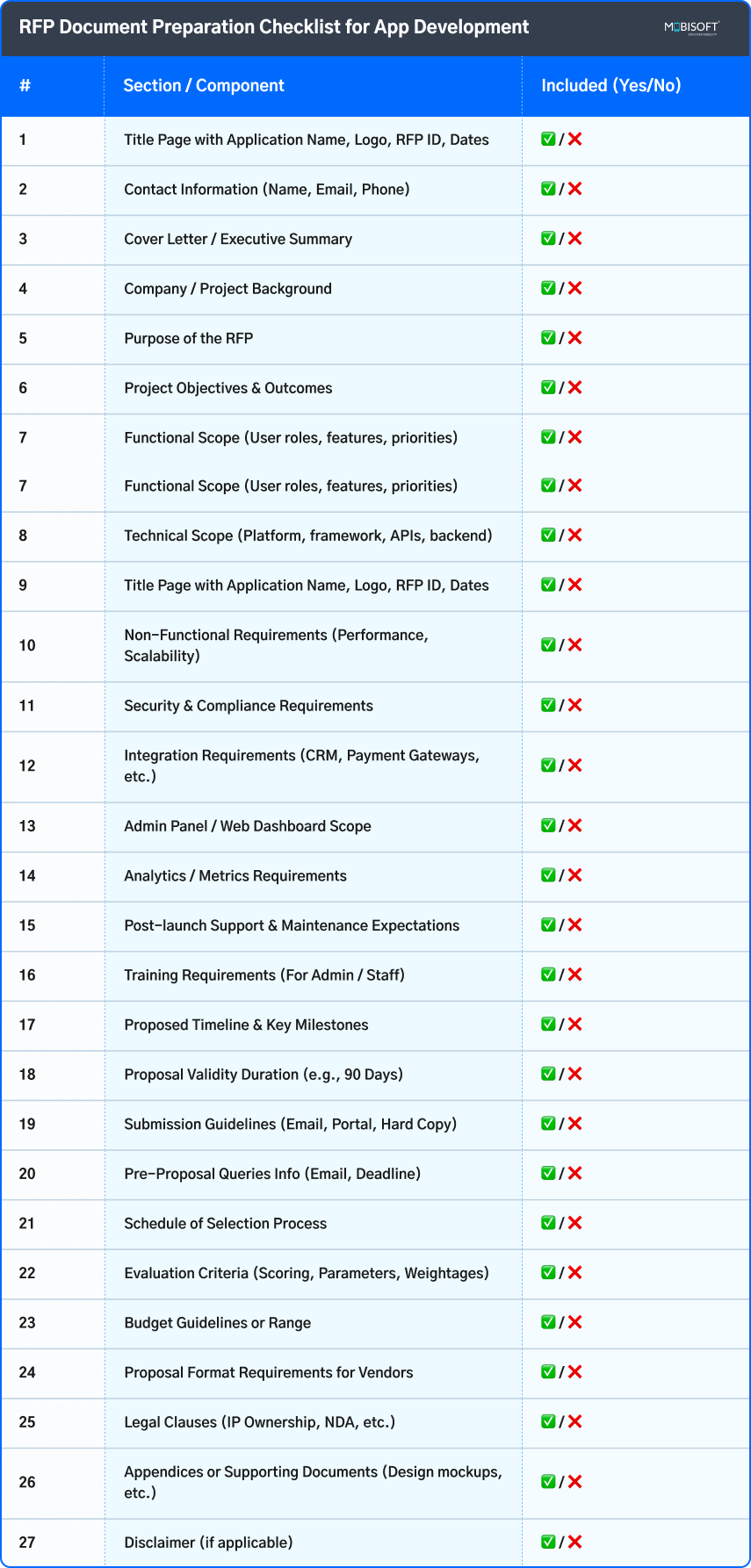
While planning to launch a new application or upgrade, creating the perfect RFP is just as important as defining the UX design process for the product itself. It greatly increases the chance of finding the right partner to assist you. A well-formulated RFP sends a clear instruction of what you aim for, require, and expect in return. This allows vendors to send the apt response, making your job of finalising easier.
A clearly structured and explained RFP helps form a much better image of your requirements among the vendors. Thus preventing delays and even financial drains.
A Thoughtful RFP Is a Signal
To vendors, a sharp, complete RFP says:
“We understand our goals, we're committed to executing this properly, and we appreciate your time.”
Such a signal draws in the top teams, who are just as invested in your product’s success as you are. It also demonstrates that you value user experience design as much as technical execution.
Ready to Build Your Solution with Confidence?
Because being ready is real confidence.
If you’re feeling motivated (or slightly overwhelmed), you don’t need to do it by yourself.
At Mobisoft Infotech, we collaborate with startups, large companies, and digitally-oriented teams spanning various sectors to:
- Review or help draft mobile app RFPs.
- Consult on project scoping and architecture.
- Design user-friendly, scalable apps across platforms.
- Deliver long-term support and improvements.
- Let us help you turn your RFP into a real-world success story.
→ Need help drafting your RFP or ready to explore your app idea?
Download our Free Mobile App RFP Template.
Looking ahead, explore insights on the future of mobile app development to plan your next steps
Frequently Asked Questions (FAQ)
Because asking is always better than assuming
Q1: How long should my RFP document be?
There’s no fixed page count, but clarity beats length; for most mid-range projects, 10–15 pages including annexures is a practical target because it lets you set the scene, make must-haves clear, and outline expectations without creating a document so long that vendors lose interest. Use headings, short paragraphs, and bullet lists to keep information scannable.
Q2: Can I issue an RFP without defining every technical requirement?
Yes, because adding every detail can make the document complex. Just make sure to add the main objectives, required tools, constraints, budget estimate, and expected results. Make sure to leave space for vendors to add their proposals and suggestions.
Q3: Do I need both a Technical and a Financial proposal?
It’s ideal to require a two-part submission so you can evaluate technical capability, approach, team, and timelines first, and then open financial bids to avoid selecting a low-cost vendor who cannot deliver and to properly assess value versus price.
Q4: Should I allow vendors to ask questions before submission?
Absolutely, provide a clear pre-proposal query window with a firm deadline and publish all clarifications to every participant so vendors don’t work on wrong assumptions and the process stays fair.
Q5: What if I receive too many proposals?
Do a quick first pass to eliminate late submissions and those missing core mandatory requirements, then apply your Evaluation Criteria and a simple scoring sheet to shortlist the best candidates for deeper review.
Q6: What are some red flags in vendor proposals?
- Too much generic or copy-paste content that could apply to any RFP
- Lack of understanding of your specific business or industry challenges
- Unrealistically low budgets or overly aggressive timelines
- No discussion of risks, dependencies, or assumptions
- Missing references or vague past project details
(If you want to cast a very wide net initially, consider withholding some sensitive details until you confirm technical alignment.)
Q7: Should I share my project budget upfront?
It is advisable to share an approximate figure of what you are willing to invest. This helps vendors to respond accordingly in one go, saving time. In case you don’t have a budget, you can ask the vendors to send a response, including their estimates.
Key Takeaways
- RFP vs RFI vs RFQ: An RFP asks for strategy and delivery from suppliers, an RFI explores possibilities only, and an RFQ covers only cost.
- Front Page Essentials: The front page must contain the RFP ID, logo, title, dates, and POC(point of contact).
- Business Problem & Objectives: Specify the business problem and quantifiable goals to help suppliers come up with feasible solutions.
- Scope Definition: Establish the scope by ranking the features in terms of user demographics and categorizing them as Essential, Desirable, or Prospective.
- Platforms & Tech Preferences: Specify the target platforms and technology preferences to avoid vendor assumptions.
- Integrations & Data Flows: Specify all mandatory integrations and define the desired data flows, including synchronization and latency-based service requirements.
- Design & Accessibility: State who provides design assets, how reviews will be performed, and whether accessibility compliance, such as WCAG, is required.
- QA & Performance Standards: Specify devices and operating systems to be assessed, tests to be run, and performance criteria like load times and bug SLAs.
- Security & Compliance: Clearly mention the authentication requirements, encryption requirements, data locality needs, and all relevant laws/regs.
- Support & Handover: State the length of post-launch support, SLA fix and response times, requirements for training, and access to the sandbox.
- Proposal Structure: The proposals should be concisely structured. Include executive summary, technical approach, team information, timeline, cost structure, and references, in that order.
- Evaluation Framework: Define the scoring criteria for proposals, such as weights, minimum ratings, evaluation steps, and decision makers.
- Budget & Timeline: Provide an attainable budget range and a milestone timeline to eliminate unsuitable proposals and enhance the efficiency of the review process.
- The Hard Truth: Unclear RFPs result in unclear proposals. A well-defined document helps shave off weeks, avoid scope creep, and minimize cost surprises.
- Vendor Checklist: Include a checklist at the end for vendors to confirm a comprehensive response. This also helps evaluators access it objectively.
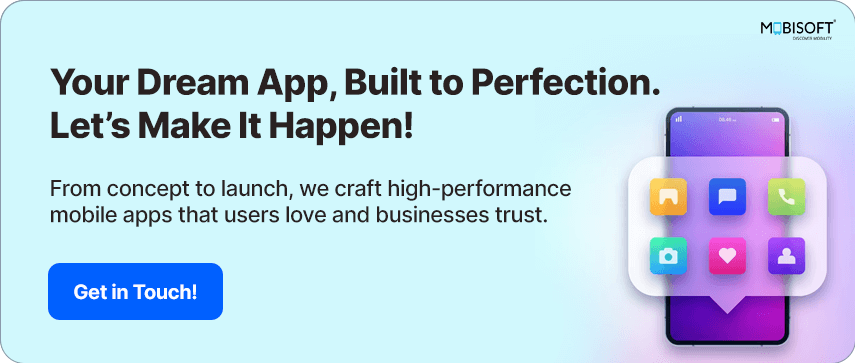

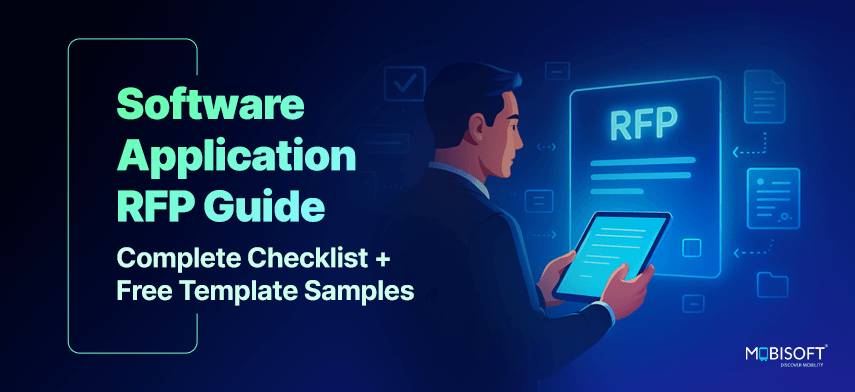


 October 10, 2025
October 10, 2025


